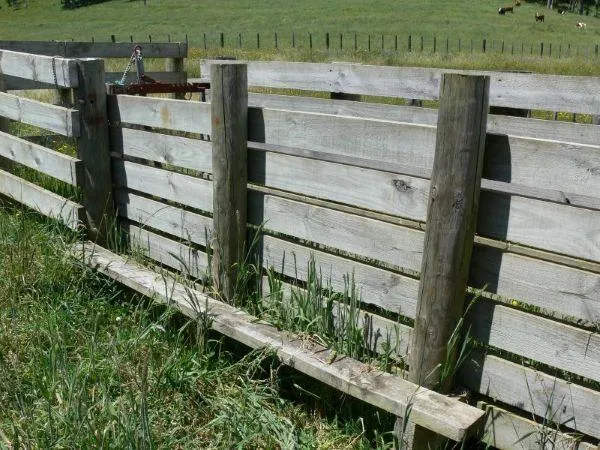
Basic yards for handling up to 5 cattle or 30 sheep
This set of plans is for a simple set of yards, suitable for the average small lifestyle block. A loading ramp can be added off the front of the headbail area at some point in the future if needed.
The yards are designed to fit into a corner in a paddock where 2 existing fence lines meet at right angles on reasonably level ground. Cut back one of the fence lines to accommodate the side of the yards with the headbail in it. If you are able to, have the topsoil scraped away and put down a compacted base of metal or lime rock before building the yards.
Posts
Use strainer posts for all the 2.7, and 2.4m posts in the yards - don't scrimp by trying to use smaller than 175mm SED posts - you might save a few dollars a post by using skinnier ones but they cost more if cattle break them (and they can). The 1.8m posts in the sheep handling area can be a little thinner. If posts are being driven with a tractor & rammer, posts need to be in ground as follows:

Spacing inside race and crush
The inside measurement between the boards in the sheep drafting race is 425mm - posts will need to be set further apart than that to allow for the thickness of the boards. The same applies to the 660mm spacing inside the crush area for the cattle - when hanging the gate that forms one side of the crush.
Timber Rails
Use 150x50mm rough-sawn H3 or H4 pine for rails in the cattle area. 5 rails evenly spaced so that the top rail is 1.5-1.6m high.
Use 150x40mm rough-sawn H3 or H4 rails in the sheep handling areas (135x32mm or similar can be substituted for 150x40). Use dressed or gauged timber rather than rough sawn in the sheep drafting race.
Nail all rails to posts with 125mm flathead galv nails - use 3 nails at every join. Use 100mm nails for the 40mm (or 32mm) thick rails.
Gates
Wooden stockyard gates should be available from your local rural timber supplier and can be made to order to fit the gate opening. Whilst they're cheaper and suitable in sheep yards, regular paddock gates aren't high enough or robust enough to use as cattle-yard gates. Steel cattle-yard gates are also an option and are easily ordered through most rural retailers. Use bolt-through gudgeons for yard gates - screw-in gudgeons aren't strong enough. Make sure gates are pinned through the gudgeons to stop cattle from lifting them off, the only exception being the sheep drafting gate.
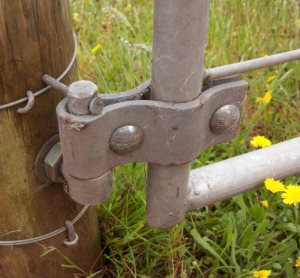
The easiest way to stop cattle from lifting gates off their hinges is to secure them through a long pin gudgeon - in this case with a 5-inch nail into the strainer post.
The plywood gates at both ends of the sheep drafting race are made from 20-22mm thick ply - 2 sheets doubled and bolted together with 600mm hinge straps and galv coach bolts. Make the ply gate at the wide end of the drafting race 1.4m high to deter cattle from trying to jump into the sheep drafting race. The ply panels on the drafting gate at the other end of the race only need to be 700-800mm high.
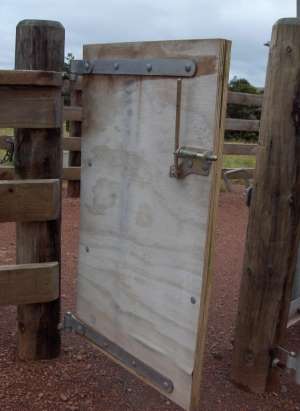
Simple & solid small gate in the yards- 2 sheets of ply bolted together with 2 heavy-duty hinge straps. (click for larger image)
The 3.6m (12 foot) gate on the optional sheep drafting pen can be a standard 1.05m high paddock gate.
Headbail
There is a wide range of options available - depending on whether you need to restrain cattle (eg for AI work, ear tagging, etc) and how much you want to spend. If your needs are simple, check with your local engineering firm or try a search on Trademe. Make sure the headbail is pinned through the gudgeons to hold it in place.
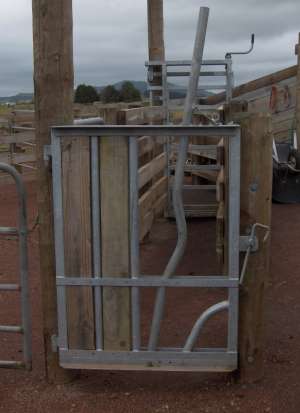
A simple headbail. (click for larger image)
Getting animals into the yards
It isn't always easy to convince cattle or sheep to go through a gate into a pen. If the yards are going in the corner of a large paddock there are a few ways to make life easier:
Run animals along the fence line towards the yards. Make sure the approach fence line is in good repair so that animals don't see 'going through it' as an escape route.
Add a "wing" fence to funnel animals into the main pen. To eliminate the sharp corner you create between the wing fence and the side of the sheep pen - fence out the triangle and plant a shade tree - poplar or willow is a good option because any prunings can be fed to stock.
Split the larger paddock down to create a smaller paddock that the yards are in. Yard your animals in 2 steps - get them into the smaller paddock, let them settle down, and then run them into the yards.
If it all goes pear-shaped and you & the animals are running around the paddock getting wound up - walk away. Go inside, have a cuppa or a cold one, let everyone settle down, then come back out and have another try.
Optional drafting pen for sheep
Adding a drafting pen is well worth it - it's achieved with very little extra materials: approx 17m of 150x40mm rails, 1 x 1.8m post & 1 or 2 x 2.4m strainers, plus a 3.6m standard gate. You may want to add a water trough - or a portable one that clicks onto a standard hose fitting - so you can hold animals overnight in the pen.

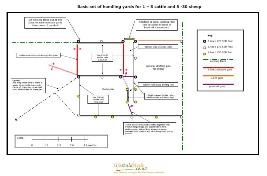
Click here to download a set of plans in PDF format.
"Before You Start Fencing" is a practical guide packed with a lifetime of experience, offering essential tips and advice to help you plan and manage fencing projects with confidence

